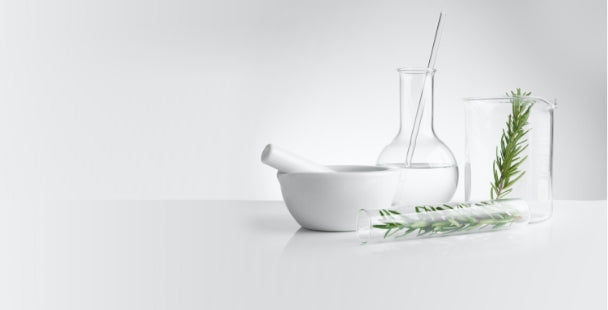
A very common statement you can find online is that 60% of whatever is applied to your skin gets get absorbed.
What is that 60% figure that is so commonly thrown around?
A very common statement you can find online is that 60% of whatever is applied to your skin gets get absorbed.
What is that 60% figure that is so commonly thrown around?
A study conducted in 1984 showed an average of 64% skin absorption rate was using solvents like toluene, xylene, and methylene chloride as the compounds tested for skin absorption. Solvents have an exceptional ability to disrupt the skin barrier, so the skin absorption rate for a solvent will be higher than most other compounds.
Yet many companies and websites have posted that finding repeatedly as if it applies to everything.
Molecules don't penetrate or absorb the skin as easily as one would think. For starters, there’s a big difference between skin penetration and absorption.
Absorption vs. Penetration
Skin absorption and penetration interchangeably used in the cosmetics world mean different things. Penetration refers to when a molecule is applied to the skin and finds its way to the deeper layers of the epidermis (the top skin layer). While absorption means the applied molecule finds its way into the dermis (middle layer of the skin), where there are vascular networks, and into the bloodstream.
Your skin’s function is to keep your organs inside, and to prevent foreign particles enter inside. And its structure reflects its functions.

Epidermis structure and Penetration routes
The top layer of your skin, the epidermis, consists of keratin, a protein inside skin cells, along with other proteins and lipids. At the very bottom of the epidermis, new skin cells, keratinocytes are formed.
As they move towards the environment,
they are change features and, at the stratum corneum layer (the superficial layer), these cells have no internal organelles, and they are dead and flat in shape. Throughout this journey, these cells are surrounded by epidermal lipids, made up of ceramides, cholesterol, cholesterol esters, and fatty acids, creating a tight physical barrier. At the stratum corneum, the dead flat cells embedded in a lipid matrix, form a waterproof barrier. This barrier prevents unwanted materials from entering, and excessive loss of water from exiting the body.
Only very small molecules can penetrate deeper into the epidermis. These molecules can penetrate through three possible routes. The intercellular route is common for oil-soluble molecules that can travel through the lipid matrix.
Another penetration route is transcellular where a molecule passes through both, the lipid matrix and through the cells. This path is difficult to pass through because molecule must first cross the lipid region and then the water-soluble region. The stratum corneum is 15 to 20 layers thick, so only very tiny molecules can absorb into skin this way.
The last penetration route is through hair follicles and pores. Once the substances get into these features, they can easily get deeper into your skin. However, this route is less common as the skin’s surface represented by hair follicles averages only 0.1-1%.
Small molecules - what does it mean?
The general rule of thumb in the industry is that anything with a molecular weight (MW) below 500 Daltons (about 8.3x10^-22 g) can penetrate the skin. For comparison: MW for Niacinamide is around 137 Daltons and MW for collagen is around 300,000 Daltons.
Large molecules just cannot travel beyond the stratum corneum.
What happens to the product applied to your skin?
When you apply a leave-on product, you feel that is it being absorbed. Actually, the product is penetrating into the stratum corneum layers providing moisturizing protective properties. It will reside at this layer until it will be shed off via a natural exfoliation process. Some product components will penetrate deeper into the epidermis.
Factors affecting penetration
The penetration of different substances into the body depends on several factors. It is the main reason some substances may get into the skin so fast, while others take time to reach the deeper layers of the skin.
- The more concentrated molecules in the substance, the easier it is to get absorbed in the skin.
- How heavy or light is the molecule? Re - 500 Dalton rule.
- How much time the product spends on the skin surface
- How fast or slow the molecule can dissolve.
- Individual’s skin health - affected by age, exposure to solvents, skincare routine, health condition, and environmental factors.
As the barrier nature tends to prevent most of the molecules to pass through it, penetration enhancers are incorporated into formulas to temporarily enhance the permeability of the skin and help with the penetration of actives.
When the skin barrier is compromised, topically applied molecules can reach areas, where they do not belong. That is why it is recommended to use mild and gentle products, as harsh products can cause barrier disruption, enhance penetration of particles, causing skin damage.
What about absorption?
Note that the epidermis doesn’t have any vascular networks to push the molecules into the bloodstream, so generally speaking, for healthy skin, absorption is unlikely. For individuals with weak, underdeveloped (for babies) or compramised barrier, the outcome can be different.
For a product to get absorbed into the bloodstream, sophisticated penetration enhancer systems are employed by the pharmaceutical industry to deliver topical drugs.
Takeaway
The truth is that skin absorption and penetration are unique in every person. But more importantly, the skin’s structure purposely is such to help with the protection of the inner cells and organs. Learning a bit more about the truths of dermal penetration can be helpful to better choose what’s right for your skin and body.
Sources:
*The 500 Dalton rule for the skin penetration of chemical compounds and drugs. Exp Dermatol 2000: 9: 165–169
*https://www.ncbi.nlm.nih.gov/pmc/articles/PMC1651599/?page=1

